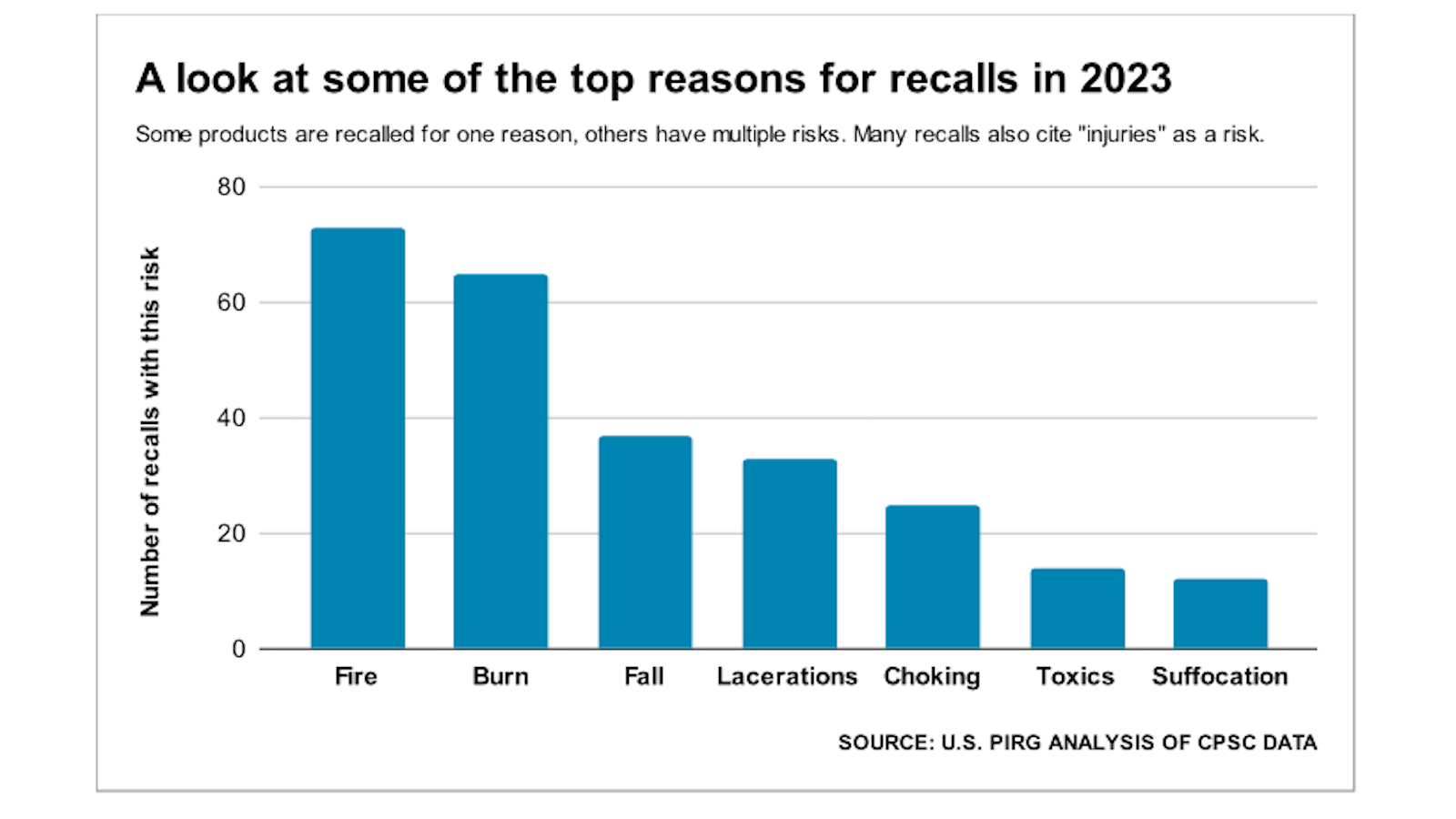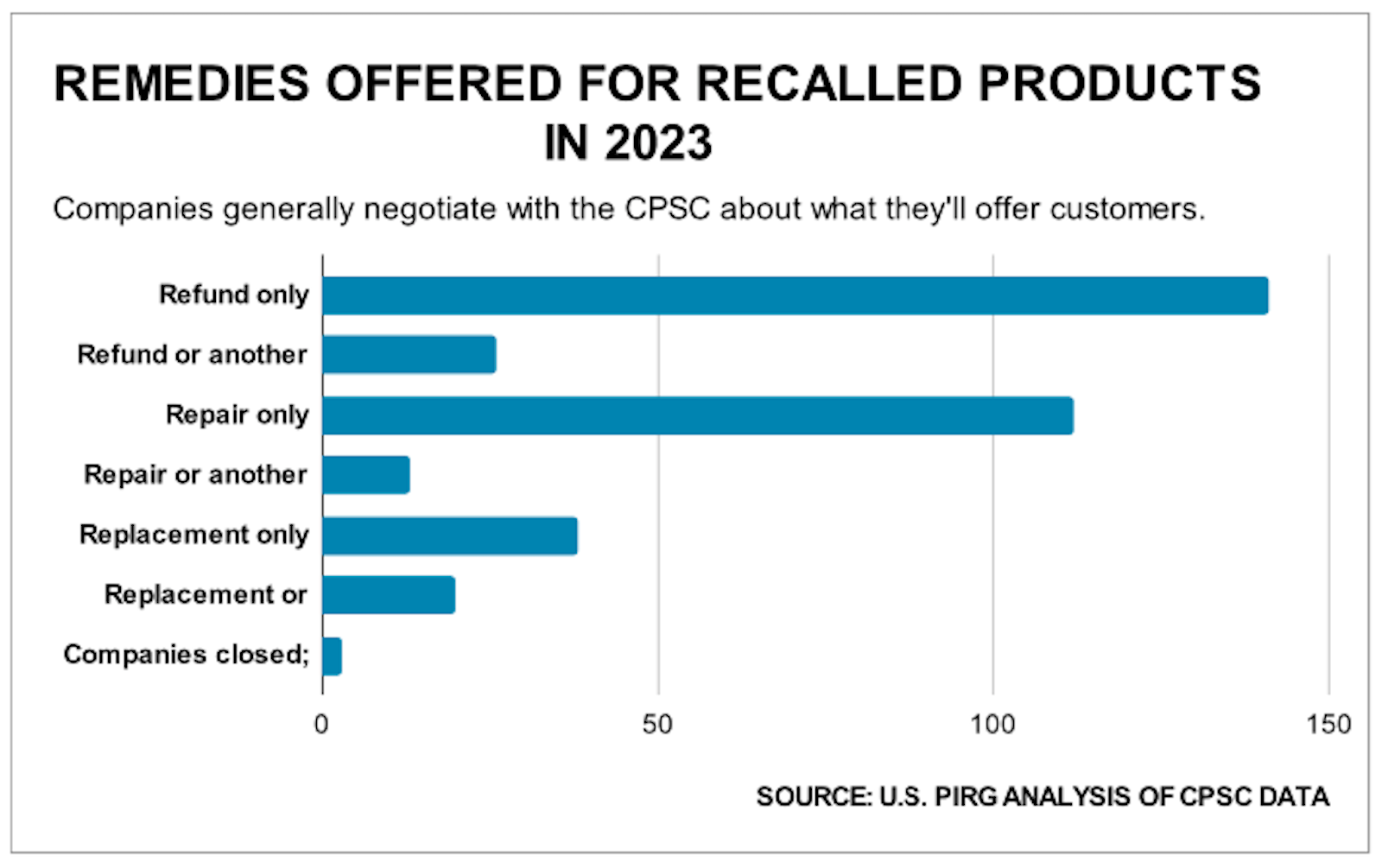Product Safety Recalls on the Rise; Refunds Often Difficult to Get
Last updated March 15, 2024
The U.S. Consumer Product Safety Commission announced 323 product recalls in 2023—the most in seven years—involving tens of millions of products, including toys, clothing, and home appliances. The recalled products were connected to more than 550 injuries, 15 deaths, and more than 500 fires, according to an analysis by the U.S. PIRG Education Fund.
Listen to audio highlights of the story below:
“It’s really clear that dangerous products threaten all of us, our children, and our homes every single day,” said Teresa Murray, U.S. PIRG Education Fund’s Consumer Watchdog director and author of the report. “And you read these reports that are filed with the CPSC, and it’s very clear that we’re not safe at home and we don’t even know it.”
The most common reasons for recalls, according to the PIRG report, include risk of fire, burns, falls, lacerations, choking, and suffocation, as well as exposure to toxic chemicals.

Some products can be banned before they hit the market if tests show they don’t meet government safety standards. But for most of the 15,000 products regulated by the CPSC, there are no testing standards. The agency must rely on complaints from consumers or reports from doctors and hospitals about unsafe products.
“It’s really important for people to look out for each other and then report it when something goes wrong. You can file a complaint really easily with the CPSC. And then hopefully, if it’s a dangerous product and not just a one-off bad luck, then it’ll help keep everyone safer,” Murray said.
Even after a safety issue has been identified, the CPSC does not have the legal authority in most cases to require the recall of dangerous products. To avoid lawsuits, the commission must negotiate with the company about the terms of the recall and the wording of the recall notice. This can take weeks, months, or longer.
“It’s clear that the recall process is not working in this country,” Murray told Checkbook. “Companies must do better. The CPSC needs to do more to encourage or even require companies to do more. And Congress, frankly, could do more by giving the CPSC more authority to recall products and also to increase the limits that companies can be penalized when they fail to report problems.”
Making Consumers Jump Through Hoops to Get a Refund
When companies do recall defective products, they offer refunds only about half the time, PIRG found. Instead, many companies provide free repairs or replace the item. But even when manufacturers offer refunds, more than half (52 percent) of them made their customers “jump through unnecessary, time-consuming hoops to get their money back,” the PIRG report concluded. These companies used complicated online forms, made consumers submit their requests by phone, or required them to return the product to the store or ship it back.
“These companies make it way too difficult, and I think there’s a reason for that,” Murray told Checkbook. “Maybe they’re trying to discourage people from returning the products to save money.”

By comparison, 48 percent of the companies that announced recalls had consumer-friendly policies. They had simple online forms. Instead of requiring the defective product be returned, they accepted a photo that showed it was destroyed or disabled. For example, a consumer could cut the cord on an electrical appliance, put a hole in a pair of children’s pajamas, or break the gasket on a blender. If these companies can do it, Murray asks, why can’t the rest?
While most refunds involved mailed checks or prepaid debit cards (often sent electronically), some companies only provided a credit toward another purchase from that company. Other companies offered prorated refunds based on the age of the product.
“Consumers deserve a refund if a product can no longer be used safely, whether they paid $2, $20 or $200,” Murray told Checkbook. “Your company made a defective, dangerous product; just give everybody their money back.”
A full cash refund is the best option for those who don’t need the item any longer or who’ve lost confidence in the product and want to buy another one, possibly from a different manufacturer, she said.
Why This Matters
Recalls are designed to prevent injuries and deaths by getting dangerous products out of the home. If the recall process is too cumbersome, consumers may continue using these dangerous items, or sell them at a garage sale or online marketplace to an unknowing buyer.
PIRG estimates that only 60 percent of all recalled products are returned or discarded. The obstacles companies create in their recall processes is “one of the reasons that so few consumers follow through with recalls,” the report concluded.
Where to Complain
To help it protect other consumers, promptly report unsafe products to the CSPC. You can use its online form, email it ([email protected]), or call its hotline (800-638-2772).
The Consumer Product Safety Commission also wants to hear from anyone who has difficulty obtaining a recall remedy. Use its online Recall Complaint Form.
“We may use these reports to identify trends or determine whether a company is meeting its recall commitments or whether the recall requires a company to take additional actions,” Judy Echavez, a CPSC spokesperson told Checkbook. “The information consumers provide will also help CPSC improve future recalls.”
The CPSC shared these tips about navigating the recall process:
- Make sure your specific product is a part of the recall. Some recalls are limited to specific batches or models of a product, and not the entire product line. Pay attention to model numbers and other product information in the recall notice to make sure what you have was part of the recall.
- Submit complete and correct information about the product. Follow all instructions and provide any documentation requested. This may include a sales receipt or photos to document that you have destroyed or disabled the product.
- Be mindful of response time. Both large and small companies sometimes struggle to respond to recalls in a timely manner. Continue to contact the company until you receive a response.
- Understand the recall remedy offered. Firms have negotiated their recall remedies with CPSC staff and voluntarily agreed to offer these remedies to consumers. The agency does not negotiate on behalf of individual consumers to try to get a higher refund or a different remedy.
More Info:
- PIRG tipsheet on how to learn about product recalls
- From Checkbook: What to do about defective products
Contributing editor Herb Weisbaum (“The ConsumerMan”) is an Emmy award-winning broadcaster and one of America's top consumer experts. He has been protecting consumers for more than 40 years, having covered the consumer beat for CBS News, The Today Show, and NBCNews.com. You can also find him on Facebook, Twitter, and at ConsumerMan.com.


